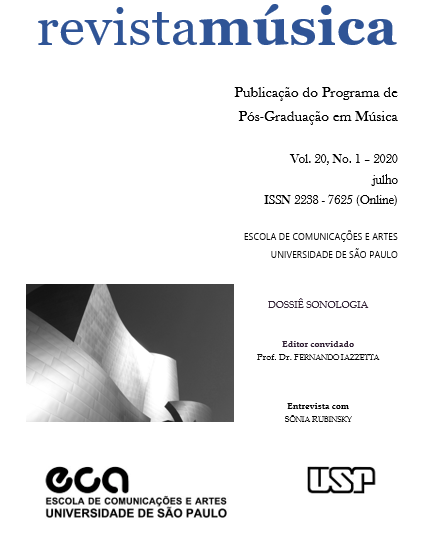The use of an interactive music system as an aid for exploring sound in music education in a rural area
DOI:
https://doi.org/10.11606/rm.v20i1.170736Palavras-chave:
Interactive music systems, Sound mobile apps, Electroacoustic music, Music educational program, Socially underserved communitiesResumo
Technology has been widely used for educational processes; in the arts several researchers have investigated the employment of computational systems and gadgets to approach younger audiences. This paper describes the design and implementation of an interactive music system used as a tool for an electroacoustic music course for children in a rural community. The system comprises a MaxMSP digital interface and an OSC Controller app for Android. Graphic User Interfaces were created in MaxMSP in order to process individual musical parameters, this can be controlled by mobile devices using Open Sound Control OSC protocols. The interactive system was used by children (6-15 years old) to explore sound worlds during a series of electroacoustic music courses and workshops.
Downloads
Referências
BACKLUND, A. The Definition of System. Kybernetes, v. 29 n. 4, p. 444–451, jun. 2000.
BOULEZ, P. Technology and the Composer. In: Emmerson, S. The Language of Electroacoustic Music. London: The Macmillan Press Ltd., 1986. 5-14.
HENNESSY, S. Coordinating music across the primary school. London: Farmer Press, 1998.
INSTITUTO Nacional de Estadística y Geografía. Encuesta intercensal 2015. Ciudad de México, MX: INEGI, 2015.
LANDY, L. Making Music with Sounds. Abingdon: Routledge, 2012.
LAROSE, D. M.; BURNS, K. J.; CHUPKA, Z. D. 2014. Available at <http://digitalcommons.wpi.edu/iqp-all/258 >. Date of access: 3 jun. 2020.
MANZO, J. V. Electro-acoustic musically interactive room EAMIR. 2007. Available at <http://www.eamir.org/ >. Date of access: 3 jun. 2020.
MANZO, J. V. Max/MSP/Jitter for Music: A practical guide to developing interactive music systems. New York, NY: Oxford University Press, 2011.
MASU, R.; CONCI, A.; CORE, C.; ANGELI, A.; MORREALE, F. Robinflok: A polyphonic algorithmic composer for interactive scenarios with children. In: Proceedings of the 14th sound and music computing conference. Espoo, Finland: SMCC, 2017. 127-32.
MUSIC Maze, Birmingham Contemporary Music Group. 2020. Available at < https://www.bcmg.org.uk/music-maze>. Date of access: 3 jun. 2020.
REAS, C.; FRY, B. Processing: A Programming Handbook for Visual Designers and Artists. London, UK: The MIT Press, 2014.
REGENMORTEL, H. Eersteklasconcerten: a different look at music participation of children in concert halls. In: Proceedings of the 8th Conference of the European Network of Music Educators and Researchers of Young Children. Cambridge, UK: MERYC2017, 2017, p. 93-100.
SECRETARÍA de Educación Pública. Plan y programas de estudio para la educación básica. Ciudad de México, MX: sep. 2017.
THE MEXICAN CENTRE for Music and Sonic Arts CMMAS. 2020. Available at < http://cmmas.org/as/ >. Date of access: 3 jun. 2020.
TOBIAS, E. Let’s Play! Learning music through video games and virtual worlds. In: McPherson, G. and Welch, G. Creativities, Technologies, and Media in Music Learning and Teaching: An Oxford Handbook of Music Education, v. 5. New York: Oxford University Press, 2018, p. 217-235.
WINKLER, T. Strategies for Interaction: Computer Music, Performance, and Multimedia. In: Proceedings of the 1995 Connecticut College Symposium on Arts and Technology. Connecticut, USA: SAT, 1995, p. 1-4.
WRIGH, M. Freed, A.; MOMENI, A. Open Sound Control: State of the Art 2003. In: Proceedings of the 2003 Conference on New Interfaces for Musical Expression. Montreal, Canada: NIME, 2003, p. 153-159.
Downloads
Publicado
Edição
Seção
Licença
Copyright (c) 2020 Mario Alberto Duarte-García, Emma Wilde, Rodrigo Cortez, Jorge Rodrigo Sigal

Este trabalho está licenciado sob uma licença Creative Commons Attribution-NonCommercial-ShareAlike 4.0 International License.
Autores que publicam nesta revista concordam com os seguintes termos:
- Autores mantém os direitos autorais e concedem à revista o direito de primeira publicação, com o trabalho simultaneamente licenciado sob a CC Attribution-NonCommercial-ShareAlike 4.0 que permite o compartilhamento do trabalho com reconhecimento da autoria e publicação inicial nesta revista.
- Autores têm autorização para assumir contratos adicionais separadamente, para distribuição não-exclusiva da versão do trabalho publicada nesta revista (ex.: publicar em repositório institucional ou como capítulo de livro), com reconhecimento de autoria e publicação inicial nesta revista.
- Autores têm permissão e são estimulados a publicar e distribuir seu trabalho online (ex.: em repositórios institucionais ou na sua página pessoal) a qualquer ponto antes ou durante o processo editorial, já que isso pode gerar alterações produtivas, bem como aumentar o impacto e a citação do trabalho publicado (Veja O Efeito do Acesso Livre).


